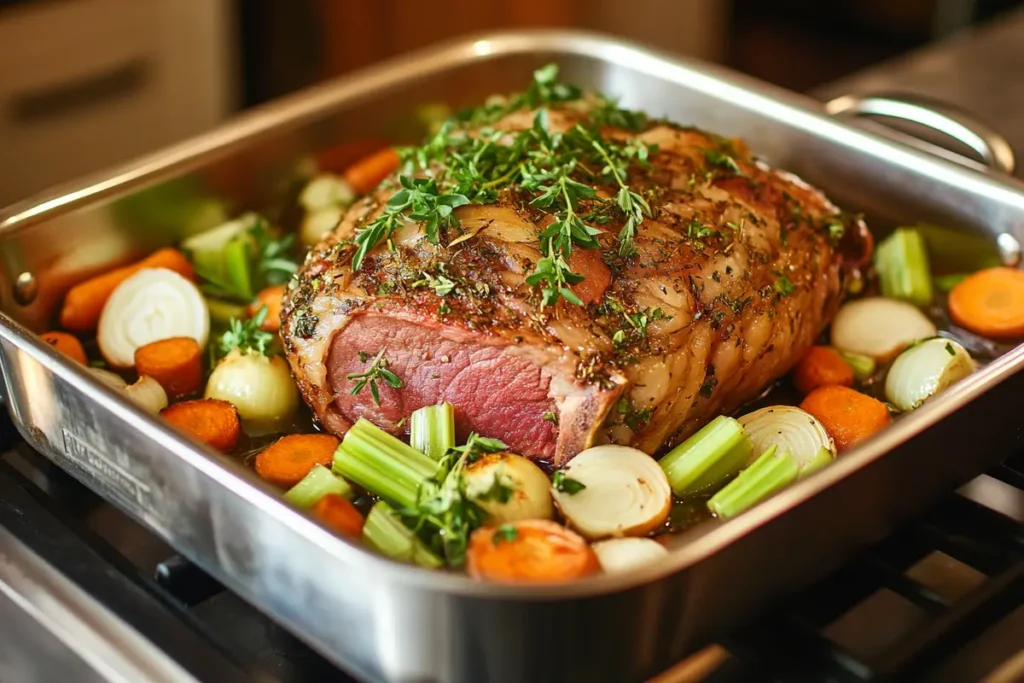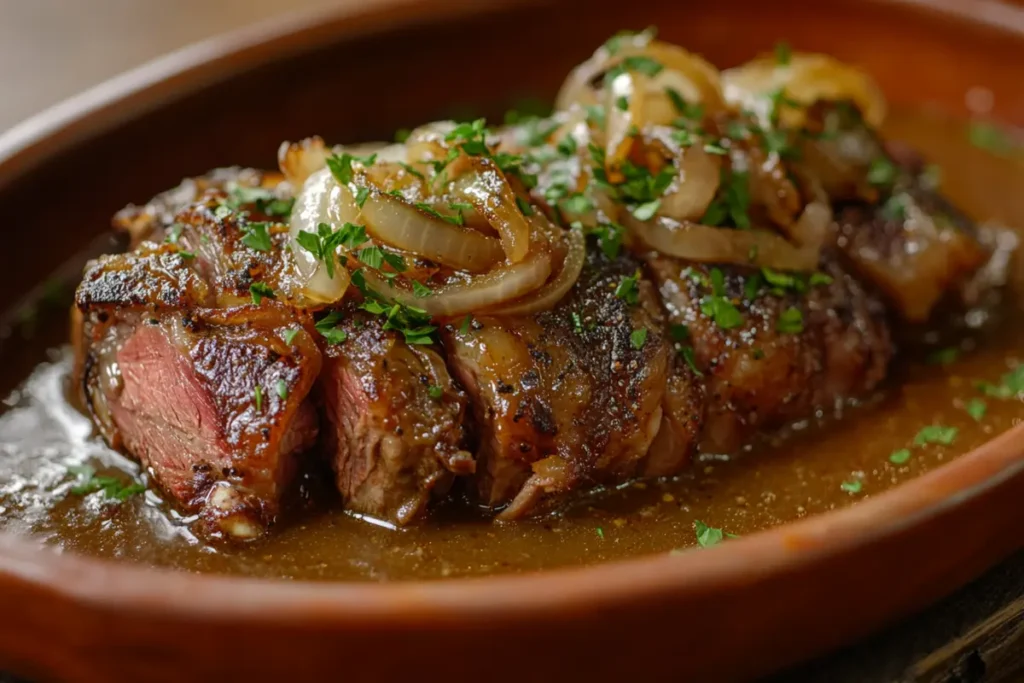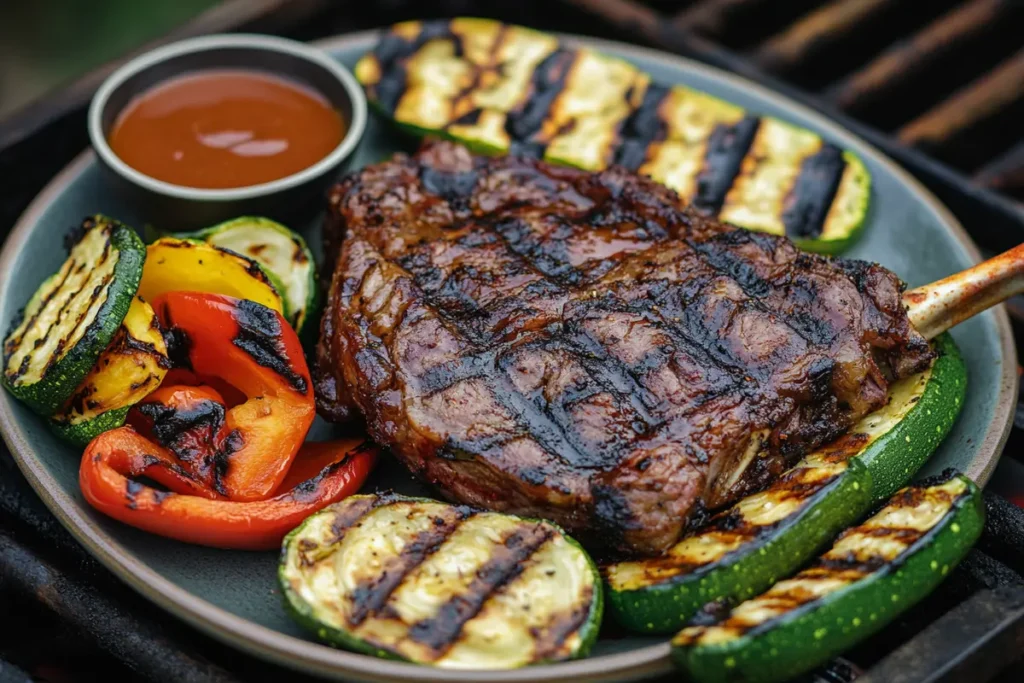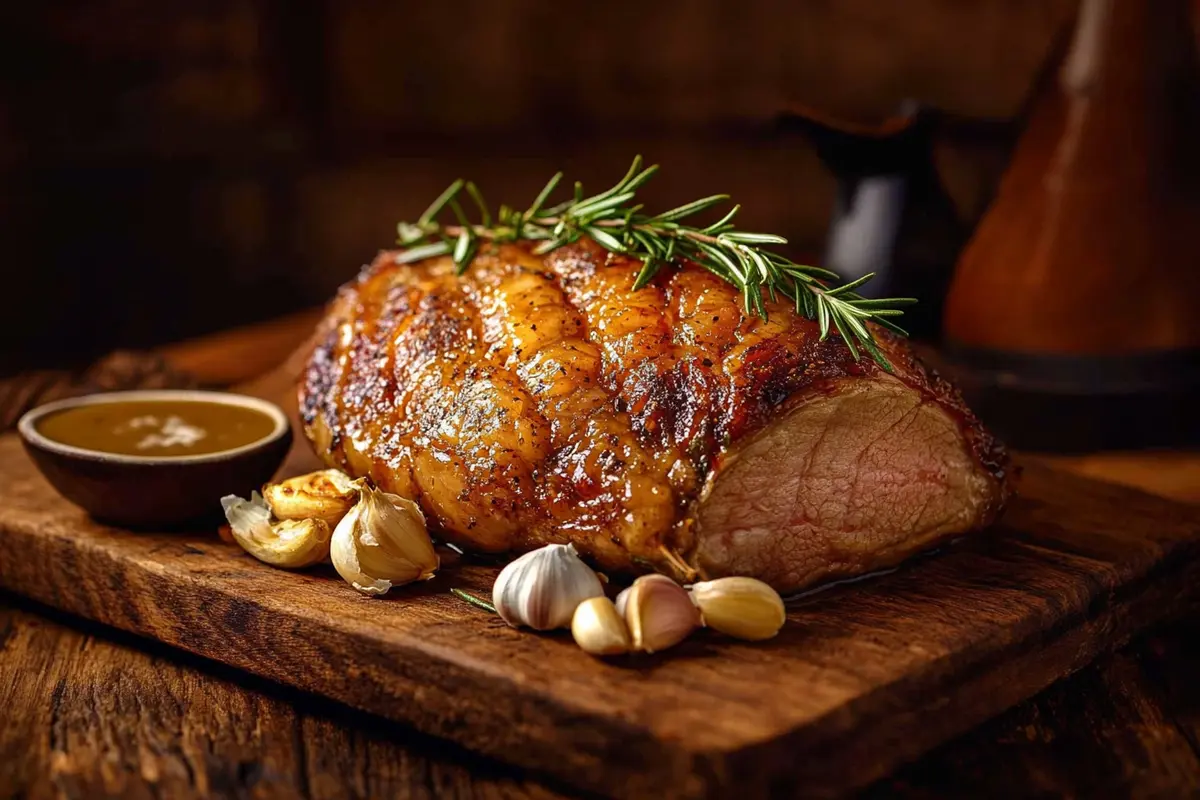Cooking a shoulder of lamb to perfection is a culinary art that brings out the best in this versatile cut of meat. Whether slow-roasting, braising, or grilling, each method offers its unique flair to create a dish that’s tender, flavorful, and satisfying. In this article, we’ll explore the best cooking techniques for shoulder of lamb, including preparation tips, optimal cooking times, and mouthwatering recipes. Let’s dive in!
Table of Contents
Understanding the Shoulder of Lamb
What Makes Lamb Shoulder Special?
The lamb shoulder is a flavorful, well-marbled cut taken from the upper front leg and shoulder blade. Its rich fat content and connective tissues make it ideal for slow-cooking methods, where these elements break down to create tender, melt-in-your-mouth meat.
Nutritional Benefits
Lamb shoulder is packed with protein, iron, and essential vitamins like B12, making it both a delicious and nutritious choice. Its natural fats keep the meat moist during cooking, enhancing flavor without overwhelming the dish.
Selecting the Right Cut
Bone-In or Boneless?
A bone-in lamb shoulder offers richer flavor and retains moisture during cooking, making it ideal for slow roasting or braising. On the other hand, boneless lamb shoulder is easier to handle and perfect for recipes requiring stuffing or slicing.
How to Choose Fresh Lamb Shoulder
Look for meat with a deep pink color and creamy white fat. Avoid cuts with grayish hues or a strong odor, as these may indicate spoilage. Always choose high-quality, fresh lamb from trusted suppliers for the best results.
Preparation Techniques
Preparing Lamb Shoulder for Cooking
A well-prepared lamb shoulder sets the stage for a dish that’s bursting with flavor. While this cut is forgiving and versatile, a few simple preparation steps can elevate your dish from good to unforgettable.
Trimming Excess Fat
Lamb shoulder naturally has a good amount of fat, which helps keep it moist and flavorful during cooking. However, too much fat can overpower the taste and make the dish greasy. To strike the perfect balance, trim away any thick layers of fat from the surface while leaving a thin layer for flavor. Use a sharp knife and take care not to cut into the meat itself.
This step is especially important for cooking methods like grilling or braising, where excess fat might not render fully during the process.
Marinating Methods
Marinating lamb shoulder infuses it with flavor and helps tenderize the meat. A good marinade includes a mix of acid (like lemon juice or yogurt), herbs, spices, and oil. For instance, a combination of garlic, rosemary, thyme, olive oil, and a splash of citrus works wonders.
- For best results, marinate the lamb shoulder for at least 6-12 hours.
- Place the meat and marinade in a resealable plastic bag or a covered dish, ensuring all surfaces are coated.
This not only enhances the flavor but also helps lock in moisture during cooking.
Seasoning Options
If you prefer to skip marinating, a simple seasoning rub can also work beautifully. Season the lamb shoulder generously with salt, pepper, and your favorite spices. Popular choices include paprika, cumin, coriander, and oregano. To create a well-rounded flavor profile, combine spices with fresh herbs like rosemary or thyme.
For an added layer of taste, consider scoring the meat’s surface before applying the seasoning. This allows the flavors to penetrate more deeply and ensures an even distribution across the cut.
Cooking Techniques
Cooking a lamb shoulder to perfection involves selecting the right technique to suit your desired flavor and texture. Whether you prefer the depth of a slow roast or the bold char of grilling, there’s a method to match every palate.
Slow Roasting
Benefits of Slow Roasting
Slow roasting is a tried-and-true method for cooking lamb shoulder. The low, steady heat gradually breaks down the connective tissues, resulting in meat that’s fork-tender and rich in flavor. This technique is perfect for gatherings or occasions where you want a centerpiece dish that’s both rustic and elegant.

Step-by-Step Guide
- Preheat the Oven: Set your oven to 300°F (150°C) for a consistent, low-temperature roast.
- Prepare the Lamb: Place the seasoned or marinated lamb shoulder in a roasting pan. For added flavor, surround it with garlic cloves, onions, and root vegetables like carrots or parsnips.
- Add Liquid: Pour in a cup of stock or water to create steam, keeping the lamb moist during the cooking process. Cover the pan tightly with foil.
- Cook Low and Slow: Roast for 3-4 hours, occasionally basting the meat with its juices. Remove the foil during the final 30 minutes to allow the exterior to brown.
- Rest Before Serving: Let the lamb rest for 15-20 minutes before carving to retain its juices.
Braising
Advantages of Braising
Braising combines moist heat and slow cooking, making it an excellent choice for lamb shoulder. This method yields tender meat infused with the flavors of the liquid and aromatics used in the braising process.

Braising Process Explained
- Sear the Lamb: Heat a large pot or Dutch oven and brown the lamb shoulder on all sides. This caramelizes the surface and adds depth to the flavor.
- Build the Base: Remove the lamb and sauté onions, garlic, and carrots in the same pot. Add tomato paste and cook briefly.
- Deglaze the Pan: Pour in a cup of stock, broth, or even orange juice to scrape up the browned bits, which are packed with flavor.
- Braise Gently: Return the lamb to the pot, cover, and cook over low heat for 2.5-3 hours. The meat should become so tender it pulls apart with a fork.
Grilling
Grilling Lamb Shoulder: Tips and Tricks
Baking imparts a smoky, slightly charred flavor to lamb shoulder. This method works best with boneless cuts, which can be butterflied for even cooking.
- Preheat the Grill: Ensure your grill is hot to achieve a good sear.
- Oil the Grates: Prevent sticking by lightly oiling the grill grates before placing the lamb.
- Use Indirect Heat: Cook the lamb over indirect heat for a more uniform doneness, flipping occasionally.

Achieving the Perfect Char
Brush the lamb with a mix of olive oil, lemon juice, garlic, and herbs before grilling. The natural sugars in the marinade caramelize over the high heat, creating a beautifully charred crust while sealing in moisture.
Smoking
Techniques of Smoking for Lamb Shoulder
Smoking is a slow process that allows the meat to absorb a deep, smoky flavor while becoming incredibly tender. Use wood chips like hickory or applewood for the best results.
- Prepare the Smoker: Preheat to 225°F (107°C) and soak your wood chips in water for at least 30 minutes.
- Season Generously: Apply a dry rub of salt, paprika, garlic powder, and thyme.
- Smoke for Hours: Place the lamb shoulder in the smoker and cook for 6-8 hours, basting occasionally.
Flavor Infusion Methods
For added flavor, consider stuffing garlic cloves and rosemary sprigs into small incisions made in the meat. This technique works wonders in complementing the smoky aroma.
Cooking Times and Temperatures
Cooking lamb shoulder to perfection requires precise timing and temperature control. This ensures that the meat is tender, juicy, and full of flavor. Each cooking method has its own optimal time and temperature range, so understanding these can make all the difference.
Optimal Cooking Times and Temperatures
The internal temperature of lamb shoulder is a critical factor that determines both safety and doneness. Depending on your cooking method and desired texture, the following guidelines will help you achieve the perfect result:
- Slow Roasting:
- Time: 3-4 hours at 300°F (150°C)
- Internal Temperature: 190°F (88°C) for fall-apart tenderness
- This method is ideal for a well-done, succulent shoulder that melts in your mouth.
- Braising:
- Time: 2.5-3 hours on low heat
- Internal Temperature: 180-190°F (82-88°C)
- Braising produces tender meat that’s infused with the rich flavors of the braising liquid.
- Grilling:
- Time: 10-15 minutes per side for medium doneness
- Internal Temperature: 145°F (63°C) for medium-rare; 160°F (71°C) for medium
- Grilling achieves a balance between a juicy interior and a beautifully charred exterior.
- Smoking:
- Time: 6-8 hours at 225°F (107°C)
- Internal Temperature: 195°F (90°C) for shreddable, ultra-tender lamb
- Smoking is all about patience and low-and-slow cooking to infuse maximum flavor.
Using a Meat Thermometer
A meat thermometer is your best friend when cooking lamb shoulder. Insert the thermometer into the thickest part of the meat without touching the bone. This gives you an accurate reading of the internal temperature, helping you avoid undercooking or overcooking.
For safety, ensure the lamb reaches a minimum internal temperature of 145°F (63°C), as recommended by food safety guidelines. However, for cuts like the shoulder, going beyond this temperature produces better results by breaking down tough connective tissues.
Serving Suggestions
Once you’ve cooked the lamb shoulder to perfection, pairing it with the right accompaniments elevates the dish even further. From classic sides to modern twists, the right pairing complements the rich, hearty flavors of lamb shoulder.
Pairing Lamb Shoulder with Sides
Traditional Accompaniments
For a timeless approach, classic sides bring out the best in lamb shoulder:
- Mashed Potatoes: Creamy, buttery mashed potatoes are the perfect counterpoint to the lamb’s robust flavors.
- Roasted Vegetables: A medley of root vegetables like carrots, parsnips, and turnips adds natural sweetness and texture.
- Mint Sauce or Jelly: This tangy condiment cuts through the richness of the lamb, offering a refreshing contrast.
- Yorkshire Pudding: For a British-inspired twist, this airy pastry works wonderfully with the savory juices of the lamb.
Modern Side Dish Ideas
If you’re looking to experiment, these contemporary sides add flair to your lamb shoulder meal:
- Quinoa Salad: A vibrant quinoa salad with pomegranate seeds, arugula, and a citrus dressing provides a refreshing, nutritious option.
- Herbed Couscous: Fluffy couscous flavored with parsley, lemon, and olive oil pairs seamlessly with braised or grilled lamb.
- Grilled Asparagus: Lightly charred asparagus spears bring a smoky, earthy element to the plate.
- Garlic-Infused Cauliflower Mash: A low-carb alternative to potatoes, this side is creamy, garlicky, and complements lamb shoulder beautifully.
Garnishing and Plating Tips
Presentation matters! Garnish your lamb shoulder with fresh herbs like rosemary, parsley, or thyme for a pop of color and fragrance. Use a large serving platter to showcase the lamb as the centerpiece, surrounded by your chosen sides for an inviting, restaurant-quality display.
Whether serving your lamb shoulder for a casual family dinner or a formal gathering, pairing it thoughtfully ensures a memorable dining experience.
Creative Uses for Leftover Lamb Shoulder
Leftover lamb shoulder is a gift that keeps on giving. Its rich, versatile flavor makes it easy to reinvent into new and exciting dishes, ensuring nothing goes to waste. With a little creativity, you can transform your leftovers into meals that are just as satisfying as the original dish.
Lamb Sandwiches
A quick and easy way to enjoy leftover lamb is by turning it into a sandwich. Shredded or thinly sliced lamb shoulder pairs perfectly with fresh bread and flavorful spreads. Try these combinations:
- Mediterranean Wrap: Layer lamb with hummus, tzatziki, arugula, and cherry tomatoes in a soft pita wrap.
- Rustic Panini: Use crusty ciabatta bread, add lamb, caramelized onions, melted Gruyère cheese, and a touch of Dijon mustard, then grill until golden and crisp.
Lamb Stew
Leftover lamb shoulder is excellent for hearty stews. The already-cooked meat absorbs flavors beautifully, making it the ideal protein for slow-simmered dishes. Here’s how to create a quick stew:
- Sauté Aromatics: Cook onions, garlic, and celery in olive oil until softened.
- Add Vegetables and Broth: Toss in chopped carrots, potatoes, and peas, followed by lamb or chicken broth.
- Incorporate Lamb: Stir in shredded lamb shoulder and simmer until the flavors meld together.
- Season and Serve: Add a dash of rosemary and thyme, and serve hot with crusty bread.
Lamb Tacos
Bring a bold twist to taco night by using leftover lamb shoulder as the filling. The tender meat works well with smoky and zesty flavors.
- Preparation: Shred the lamb and sauté with taco seasoning or a mix of cumin, paprika, and lime juice.
- Assembly: Serve on warm corn tortillas with toppings like guacamole, diced onions, and fresh cilantro.
Shepherd’s Pie
Transform your lamb leftovers into a classic shepherd’s pie. This comforting dish is simple to prepare and perfect for feeding a crowd:
- Layer the Base: Spread shredded lamb mixed with gravy or sauce at the bottom of a baking dish.
- Add Vegetables: Scatter peas, carrots, and corn over the meat layer.
- Top with Mash: Cover everything with a layer of creamy mashed potatoes, smoothing it with a fork for texture.
- Bake: Cook at 375°F (190°C) until the top is golden brown and the filling is bubbly.
Lamb Salad
For a lighter option, use lamb shoulder in a refreshing salad. Combine it with greens, roasted vegetables, and a tangy vinaigrette for a balanced meal:
- Base: Start with a mix of arugula, spinach, or romaine lettuce.
- Additions: Include roasted sweet potatoes, toasted nuts, and crumbled feta cheese.
- Dressing: Drizzle with a lemon-tahini dressing or a balsamic glaze for extra flavor.
Tips for Storing Leftover Lamb Shoulder
To keep your lamb fresh and ready for reuse:
- Refrigeration: Store leftovers in an airtight container in the fridge for up to 3-4 days.
- Freezing: Freeze portions in vacuum-sealed bags or airtight containers for up to 3 months. Defrost in the refrigerator overnight before reheating.
With these creative ideas, your leftover lamb shoulder will never go to waste, giving you endless opportunities to enjoy its delicious taste.
FAQs about Cooking Lamb Shoulder
What is the best cooking method for lamb shoulder?
The best cooking method for lamb shoulder largely depends on your preferences and the occasion. Slow roasting is ideal for fall-apart tenderness, while braising adds rich, deep flavors. For a smoky aroma, smoking is a fantastic option, and grilling offers a bold charred taste. Each method highlights the lamb’s natural richness in its unique way.
How long should I marinate lamb shoulder?
For optimal flavor, marinate lamb shoulder for at least 6-12 hours. If time allows, overnight marination works wonders as it helps the flavors deeply penetrate the meat. Be sure to use a mix of acid, herbs, and spices for the best results.
Can I cook lamb shoulder in a slow cooker?
Absolutely! Lamb shoulder is perfect for a slow cooker because its tough fibers break down beautifully over low, moist heat. Cook on low for 6-8 hours or on high for 4-6 hours, adding vegetables and seasoning for a complete, hearty meal.
What internal temperature should lamb shoulder reach?
The internal temperature for lamb shoulder depends on the desired doneness:
- Medium-rare: 145°F (63°C)
- Medium: 160°F (71°C)
- Well-done: 190°F (88°C) for tender, fall-apart results.
Always use a meat thermometer to ensure accurate cooking.
Conclusion: Mastering Lamb Shoulder Cooking Techniques
Cooking lamb shoulder to perfection is both an art and a rewarding culinary journey. From the rich, fall-apart tenderness of slow roasting to the smoky allure of grilling, each technique brings out the best in this versatile cut of meat. By starting with high-quality lamb, preparing it thoughtfully with marinades or rubs, and selecting the right cooking method, you can create dishes that are not only flavorful but also memorable.
Whether you’re serving it as a centerpiece for a family gathering or reinventing leftovers into creative new meals, lamb shoulder proves its worth every time. Its deep flavor, tender texture, and adaptability make it a favorite among chefs and home cooks alike. So, experiment with these techniques, pair it with complementary sides, and savor the delicious results.

